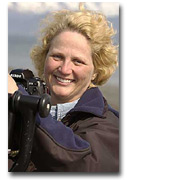
|

Building Web Site Credibility
Copyright Jan Allinder
All rights reserved.
Designing and maintaining a successful web site takes a lot of planning (see Roadmap for a Successful Web Site) and hard work. With the thousands of nature and wildlife photography web sites, how can you compete with the rest? Establish credibility.
Building web site credibility revolves around your ability to provide accurate information about subjects, products or techniques that you are experienced with and knowledgeable about. There are a number of things that you can do when designing your web site to boost your site’s credibility.
Web Site Credibility DOs
- Create a professional design that compliments your style of photography. This includes a layout with good use of fonts, color schemes and white space.
- Provide a consistent, easy way to navigate your site.
- Provide site search capability. Help the visitor find the information within your site quickly.
- Provide Contact Information - Your name, physical address, e-mail address and phone number should appear on each page of your web site. (You should also include your URL and e-mail address on your business cards and letterhead.)
- Have established, well-known web sites link to your site. These links also serve as an “endorsement”. Request links from web sites that have related content. Be sure to provide a link to the sites that link to yours.
- Provide additional links or references for the content on your web site. When you write a product review, include the link to the manufacturer’s web site. When you write about a certain location or species, provide useful links for that area or species.
- Provide a Mission Statement and Biography. Be sure to include your photo, affiliations and the purpose (goals) of your site. You might also want to include your photo credits and/or a stock photo list.
- Respond quickly to requests regarding your web site or images.
- Update your site with original content and new images on a regular basis. At the very least, you should add new material every other month.
- Verify the accuracy and relevancy of your content.
- Provide printer-friendly pages. Either create a separate, printer-friendly web page for your articles or create a cascading style sheet for print media.
- Name recognition and reputation. Your credibility increases the more your name and domain name are seen, whether on the Internet or in publications.
- High search engine rankings. Optimize your web site for search engines.
- Fast and dependable hosting. Your site should load quickly and be reliable (uptime 99%).
- Provide web site accessibility. Every image on your web site should contain an ALT tag. Proper use of style sheets can assure that everyone who visits your site can view the content.
- Simple is better. While Flash-enabled sites may look good, they often turn away potential customers with slower connections. It's much more difficult for Flash-enabled or frame-based sites to get a high ranking with search engines such as Google. Keep in mind that splash pages and the use of image maps for navigation can hinder a search engine's ability to index your site.
Many web sites unintentionally destroy their credibility by being careless or unorganized. Here are a few often-overlooked items that can have a negative effect on your site’s credibility.
Web Site Credibility DON’Ts
- Typographical or grammatical errors – Have someone else proof-read your material. Sometimes you overlook obvious mistakes.
- Invalid or broken links
- Pop-up advertising
- Too many ads throughout the site
- Links to non-credible sites – Only link to related, well-established web sites.
- Domain name does not match business or company’s name – Select a domain name that either uses your name, business name or field.
- Rarely update site with new content
- Use a free hosting service
Internet users are becoming more and more skeptical of the information and services provided online. Your job is to make sure the visitors to your site feel comfortable. By following the web site credibility guidelines listed above you are well on your way to establishing credibility and web site recognition.
References & Resources
Stanford-Makovsky Web Credibility Study 2002 – www.webcredibility.org
Consumer Web Watch – www.consumerwebwatch.org
SiteTechnician – www.sitetechnician.com
The W3C MarkUp Validation - http://validator.w3.org
Jan Allinder - NPN 015
Lucid Images Wildlife Photography
Comments on NPN web site design articles? Send them to the editor.

Jan Allinder is not only an avid nature photographer, but a talented webmaster as well. A member of the HTML Writers Guild, Jan thoroughly enjoys designing and creating web pages, including those for Moose Peterson, and Jerry and Barbara Jividen. Jan has been working with
computers for over ten years, and believes that the Internet is a fantastic place to learn, meet new
people and have a good time. Her primary goal when designing any web site is to help educate the public. Jan's e-book, A Photographer's Guide to Web Site Design is a resource of useful information for any nature photographer with an interest in building their own web site.
To view Jan's work, be sure to pay her Lucid Images Wildlife Photography web site a visit!


|

